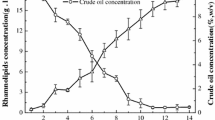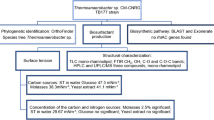Abstract
The biodegradation of oil products in the environment is often limited by their low water solubility and dissolution rate. Rhamnolipids produced by Pseudomonas aeruginosa AT10 were investigated for their potential to enhance bioavailability and hence the biodegradation of crude oil by a microbial consortium in liquid medium. The characterization of the rhamnolipids produced by strain AT10 showed the effectiveness of emulsification of complex mixtures. The addition of rhamnolipids accelerates the biodegradation of total petroleum hydrocarbons from 32% to 61% at 10 days of incubation. Nevertheless, the enhancement of biosurfactant addition was more noticeable in the case of the group of isoprenoids from the aliphatic fraction and the alkylated polycyclic aromatic hydrocarbons (PHAS) from the aromatic fraction. The biodegradation of some targeted isoprenoids increased from 16% to 70% and for some alkylated PAHs from 9% to 44%.
Similar content being viewed by others
References
Abalos A, Deroncelé V, Espuny J, Bermúdez R & Manresa A (2000) Surface active rhamnolipids accumulation by Pseudomonasaeruginosa AT10 from a vegetal oil refinery wastes. Revista Cubana de Química. XII, 24-29
Abalos A, Pinazo A, Infante R, Casals M, García F & Manresa A (2001) Physico chemical and antimicrobial properties of new rhamnolipids produced by Pseudomonas aeruginosa AT10 from soybean oil refinery wastes. Langmuir 17: 1367- 1371
Aceves M, Grimalt J, Albaigès J, Broto F, Comellas L & Grassiot M (1988) Analysis of hydrocarbons in aquatic sediments. II. Evaluation of common preparative procedures for petroleum and chlorinated hydrocarbons. J. Chromatogr. 436: 503-509
Adamson A & Gast A (1997) Emulsions. Foams and aerosols. In: Physical Chemistry of Surfaces (pp 500-528). Wiley and Sons, New York
Alexander M (1999) Biodegradation and bioremediation, 2nd edn. Academic Press, San Diego, CA
Altschul SF, Madden TL, Schäffer AA, Zang J, Zang Z, Miller W & Lipman DL (1997) Gapped BLAST and PSI-BLAST: a new generation of protein database search programs. Nucleic Acid Res. 25: 3389-3402
Atwood D & Florence, AT (1983) Phase behaviour of surfactants. In: Surfactant Systems, Their Chemistry, Pharmacy and Biology (pp 40-70). Chapman & Hall, London
Barkay T, Navon-Venezia S, Ron EZ & Rosenberg E (1999) Enhancement of solubilization and biodegradation of polyaromatic hydrocarbons by the bioemulsifier alasan. Appl. Environ. Microbiol. 65: 2697-2702
Britton LN (1984) Microbial degradation of aliphatic hydrocarbons. In: Gibson DT (Ed) Microbial Degradation of Organic Compounds (pp 89-129). Marcel Dekker, New York
Casellas M, Fernandez P, Bayona JM & Solanas AM (1995) Bioassay-directed chemical analysis of genotoxic components in urban airborne particulate matter from Barcelona (Spain). Chemosphere 30: 725-740
Casellas M, Grifoll M, Sabaté J & Solanas AM (1998) Isolation and characterization of a 9-fluorenoned-degrading bacterial strain and its role in synergistic degradation of fluorene by a consortium. Can. J. Microbiol. 44: 734-742
Chandrasekaran EV & Bemiller JN (1980) Constituent analysis of glycosaminoglycans. In: Wrhiste L and Wolfrom ML (Eds) Methods in Carbohydrate Chemistry (pp 89-97). Academic Press, New York
Clayton JR, Payne JR & Farlow JS (1992) Oil Spill Dispersants: Mechanisms of Action and Laboratory Tests. CRC Press Inc., Boca Raton, FA
Desai JD & Banat IM (1997) Microbial production of surfactants and their commercial potential. Microbiol. Mol. Biol. Rev. 61: 47-64
Déziel E, Lépine F, Dennie D, Boismenu D, Mamer O & Villemur R (1999) Liquid chromatography/mass spectrometry analysis of mixture of rhamnolipids produced by Pseudomonas aeruginosa strain 57RP grown on mannitol or naphthalene Biophys Biochim. Acta 1440: 244-252
Fernandez P, Grifoll M, Solanas AM, Bayona JM & Albaigés J (1992) Bioassay-directed chemical analysis of genotoxic components in coastal marine sediments. Environ. Sci. Technol. 26: 817-829
Florence AT & Atwood D. (1998) Emulsions. In: Physico-Chemical Principles of Pharmacy (pp 252-307) Palgrave, New York.
Foght JM, Gutnick DL & Westlake DWS (1989) Effect of emulsan on biodegradation of crude oil by pure and mixed cultures. Appl. Environ. Microbiol. 55: 36-42.
Griest WH, Tomkins BA, Epler JL & Rao TK (1979) Characterization of multialkylated polycyclic aromatic hydrocarbons in energy-related materials. In: Jones PW and Leber P (Eds) Carcinogenesis, Vol. 4 (pp 395-409). Raven-Press, New York
Haba E, Abalos A, Jáuregui O, Espuny MJ & Manresa A (2003) Use of liquid-chromatography-mass spectroscopy for studying the composition and properties of rhamnolipids produced by different strains of Pseudomonas aeruginosa. J. Sur. Det. 6: 155-161
International Association of Research Chemists (1983) IARC monographs on the evaluation of the carcinogenic risk of chemicals to humans. Polynuclear aromatic compounds. Part. 1. Int. Assoc. Res. Chem. Monogr. 32: 355- 364
Kanga SA, Bonner JS, Page CA, Mills MA & Autenrieth RL (1997) Solubilization of naphthalene and methyl-substituted naphthalenes from crude oil using biosurfactants. Environ. Sci Technol 31: 556-561
LaVoie EJ, Bedenko V, Hirota N, Hecht SS & Hoffmann D (1979) A comparison of the mutagenicity, tumor initiating activity and complete carcinogenicity of polynuclear aromatic hydrocarbons. In: Jones PW and Leber P (Eds) Carcinogenesis, Vol. 4 (pp 705-721). Raven Press, New York
Linos A, Reichelt R, Keller U & Steinbuchel A (2000) A gramnegative bacterium, identified as Pseudomonas aeruginosa AL98, is a potent degrader of natural rubber and synthetic cis-1,4-polyisoprene. FEMS Microbiol. Lett. 182: 155- 161
Maidak BL, Cole JR, Lilburn TG, Parker Jr CT, Saxman PR, Stredwick JM, Garrity GM, Olsen GJ, Pramanik S, Schmidt TM & Tiedje JM (2000) The RDP (Ribosomal Database Project) continues. Nucleic Acids Res. 28: 173-174
Morgan P & Watkinson RJ (1994) Biodegradation of compounds of petroleum. In: Ratledge C (Ed) Biochemistry of Microbial Degradation. Kluwer Academic Publishers, Dordrecht
Pearson WR & Lipman DJ (1988) Improved tools for biological sequence analysis, Proc. Natl. Acad. Sci. USA 85: 2444- 2448
Reiling HE, Thanei-wyss U, Guerra-Santos LH, Hirt R, Käppeli O & Fiechter A (1986) Pilot plant production of rhamnolipid biosurfactant by Pseudomonas aeruginosa. Appl. Environ. Microbiol. 51: 985-989
Ron EZ & Rosenberg E (2002) Biosurfactants and oil bioremediation. Curr. Opin. Biotechnol. 13: 249-252
Sekelsky AM & Shreve GS (1999) Kinetic model of biosurfactant-enhanced hexadecane biodegradation by Pseudomonasaeruginosa. Biotechnol. Bioeng. 63: 402-409
Speight JG (1991) The Chemistry and Technology of Petroleum. John Wiley & Sons, New York
Solanas AM, Parés R, Bayona JM & J Albaigès J (1984) Degradation of aromatic petroleum hydrocarbons by pure microbial cultures. Chemosphere 13: 593-601
Sugiura K, Ishihara M & Shimauchi T (1997) Physicochemical properties and biodegradability of crude oil. Environ. Sci. Technol. 31: 45-51
Van Dyke MI, Couture P, Brauer M, Lee H & Trevors TJ (1993) Pseudomonas aeruginosa UG2 rhamnolipid biosurfactant: structural characterization and their use in removing hydrophobic compounds from soil. Can. J. Microbiol. 39: 1071-1078
Verschueren K (1997) Handbook of Environmental Data on Organic Chemicals. Van Nostrand Reinhold Company, New York
Viñas M, Grifoll M, Sabaté J & Solanas AM (2002) Biodegradation of a crude oil by three microbial consortia of different origins and metabolic capabilities. J. Ind. Microbiol. Biotechnol. 28: 252-260
Wilson K (1987) Preparation of genomic DNA from bacteria. In: Ausubel FM, Brent R, Kingston RE, Moore DD, Seidman JG, Smith JA, Struhl K. (Eds) Current Protocols in Molecular Biology (pp. 2.4.1-2.4.2). John Wiley, New York
Willumsen PA, Karlson U & Pritchard PH (1998) Response of fluoranthene-degrading bacteria to surfactants. Appl. Microbiol. Biotechnol. 50: 475-483
Zhang YM & Miller RM (1992) Enhanced octadecane dispersion and biodegradation by a Pseudomonas rhamnolipid surfactant (Biosurfactant). Appl. Environ. Microbiol. 60: 2101-2106
Zhang YM & Miller RM (1994) Effect of a Pseudomonasrhamnolipid biosurfactant on cell hydrophobicity and biodegradation of octadecane. Appl. Environ. Microbiol. 60: 2101-2106
Zhang YM, Maier WJ & Miller RM (1997) Effect of rhamnolipids on the dissolution, bioavailability and biodegradation of phenanthrene. Environ. Sci. Technol. 31(8): 2211-2217
Author information
Authors and Affiliations
Rights and permissions
About this article
Cite this article
Abalos, A., Viñas, M., Sabaté, J. et al. Enhanced Biodegradation of Casablanca Crude Oil by A Microbial Consortium in Presence of a Rhamnolipid Produced by Pseudomonas Aeruginosa AT10. Biodegradation 15, 249–260 (2004). https://doi.org/10.1023/B:BIOD.0000042915.28757.fb
Issue Date:
DOI: https://doi.org/10.1023/B:BIOD.0000042915.28757.fb




